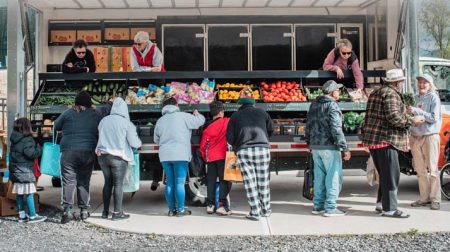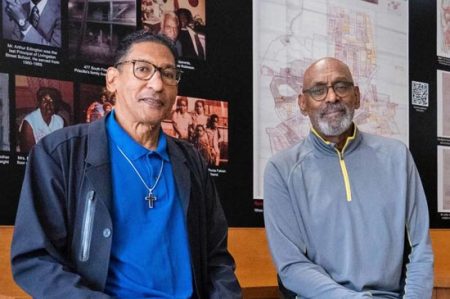Affordable Housing
 |
| photo by Cathryn Shaffer |
by Elsa Enstrom
As more people relocate to Asheville, raising the demand and prices for homes, the lack of affordable housing has become ever more important to area residents. The average cost of renting an apartment in Asheville is about $737, according to a study done by Mountain Housing Opportunities.
The study also shows that an electrical and electronic equipment assembler, who earns an average wage of $11.76 per hour, faces an affordability gap of $126 per month. Nurses\’ aides, food service and food-preparation workers, and cashiers all make even less. For people who work in these and other low-paying jobs, it is very difficult to keep a home in Asheville.
Affordable Housing Coalition
Several organizations, including the Affordable Housing Coalition, have
been active in helping people with lower incomes find better housing
and, by extension, make a better life for themselves. AHC programs are
open to the entire community, though they are aimed at people earning
between 30% and 80% of the median income. The Coalition strives to
remain “client-centric,” which means that they center all their
programs and services around what fits best for the client. “You have
to be responsive to the community,” says AHC Executive Director
Philippe Rosse.
A central part of the AHC mission is its recognition that housing
problems do not exist in a vacuum. In addition to social forces that
keep housing prices high and keep many affordable units substandard,
there can be family, personal, and cultural weaknesses that aggravate
housing problems. Helping clients learn to plan a better life by
addressing such underlying issues is an important part of the AHC\’s
work. The organization assists its clients mainly through three
programs: the Homebuyer Education Program, Home Base Rental Assistance,
and Interlace.
The Homebuyer education program teaches low- to moderate-income
families how to find a house by working with other nonprofit
organizations (such as Habitat and Mountain Housing Opportunities) and
with local financial institutions.
Home Base uses education and counseling to prepare families to be more
self-sufficient in finding and maintaining rental housing, including
intervening or mediating in landlord-tenant relationships.
Interlace is an 18-month program to help battered adults and children
find and acquire a safer environment to live in. Interlace offers
counseling and educational sessions to help families overcome obstacles
that often underlie and echo their lack of safe, affordable housing.
It is significant that AHC offers clients several types of counseling
and training in working towards self-sustainability. The Coalition
believes that it is crucial to develop a comprehensive plan of action
rather than simply find a new place to live: families need security,
self-empowerment, better earnings, and access to support services. The
organization works to support clients by helping to find childcare and
by working with community leaders in lobbying for and developing
programs to increase the supply of affordable housing in the area.
The AHC is also in the process of implementing a recently developed
10-year plan to help fight homelessness, which will focus on the small
group of chronically homeless who take up a disproportionate share of
available funds and support services. The AHC is collaborating on this
program with many other organizations in Asheville.
Mountain Housing Opportunities
Also active in facing the challenge of developing affordable housing in
Asheville is Mountain Housing Opportunities, which renovates and builds
quality affordable homes for lower-income residents. Since renovating
its first home in 1991, MHO has made available more than 80 homes,
usually with the help of systems such as “sweat equity.” Under that
program, a family that wants a house must contribute its own labor.
While the majority of the construction is still done by professionals,
the family\’s work is factored into the cost of the home, keeping the
cost and the price down. Mountain Housing also arranges mortgages that
can be as low as 1.0 percent, depending on need.
MHO also supports “green” building, to ensure that houses are
energy-efficient and thus minimize future living costs to the owner.
Green homes are built with materials and processes that are considered
and more “healthy” than traditional materials.
In addition to building new homes, MHO has developed programs to help
homeowners who cannot afford needed repairs, especially those that
cause immediate risks to health or life. The Emergency Home Repair
program covers such problems as fire hazards, unsafe porches, rotted
floors, and lack of smoke detectors, and in the winter helps repair or
replace furnaces for elderly and low-income individuals. MHO also
participates in is the Ramp Festival every spring, sending out
volunteers to build ten handicap ramps for the disabled.
Outside Asheville, the MHO\’s Rural Rehabilitation program has helped
more than 110 homeowners throughout Buncombe County have safer and more
energy efficient homes.
MHO relies heavily on volunteers. Though required to be at least high
school age, volunteers don\’t need previous carpentry experience; many
participate through others organizations and churches, while others
sign up as individuals. For more information about Mountain Housing
Opportunities, visit the organization\’s web site at www.mtnhousing.org.
Those interested in volunteering should call David Sluder at
(828)254-4030 or e-mail [email protected].
Asheville Housing Authority
The Housing Authority of the City of Asheville operates two programs
that address affordable housing: Public Housing and the Federal Section
8 program. In theory, public housing is a transitional program that
allows people to get on their feet, develop their resources, and then
move into housing in the private sector. In fact, many families remain
in public housing for decades, even several generations. The housing
projects are owned by the City and are available to all low-income
residents.
Public housing apartments range from studios to five bedrooms. Rent is
usually calculated as 30% of a family\’s adjusted gross income, though
families can request a need-based flat rent for a period of three
years, after which they must reapply.
Utility costs in public housing are paid in one of two ways. They can
be added to the base rent and paid by the Housing Authority (the
Authority reads the meter and pays the bill). Alternatively, costs are
calculated for each apartment, the rent is lowered accordingly, and the
tenant pays the bills. The Housing Authority gives preference to former
tenants and to homeless residents in accepting applicants; however,
restrictions apply to those who have been convicted of certain crimes
or rule-breaking.
Section 8 housing is designed to serve only people with extremely low
incomes; housing is privately owned and subsidized by vouchers. The
money originates from the federal government and the state. Rent rates
are determined by fair market value; a family\’s income determines the
size of the subsidy. The Housing Authority signs a lease agreement with
the landlord and passes through grant money to pay the monthly rent.
Section 8 houses must be inspected periodically to maintain eligibility
for subsidies.
Both Section 8 and Public Housing are open to any family that qualifies
financially. Additionally, the Housing Authority operates specialty
programs such as HOPWA, which helps house people with AIDS, and
Mainstream, which helps people with mental disabilities find housing.
Assistance is also available to first-time homeowners in the form of
down payment assistance.
Despite its unquestioned value to those in need, public housing carries
a burden: attitudes among the general public. “There is a stigma
attached to [people living in public housing],” says Gene Bell,
Executive Director of the Asheville Housing Authority, “just like with
any other group who stands out.” According to Bell, there are many
misconceptions about residents in government-subsidized housing, but
for the most part they are simply struggling families without the
resources to find a decent place to live without some assistance.
America has long been considered a beacon of opportunity, but
throughout its history there have also been those who cannot get ahead
no matter how hard they work and save. Like miners dependent on the
company store, who grow “another day older and deeper in debt,” it can
be impossible for a working family to put money aside for the future.
Few minimum-wage jobs offer health insurance; even a visit to an eye
doctor for a child in school who needs glasses can bust the budget for
several months.
Many families with two working parents cannot afford childcare, and
even those who can are often faced with long waiting lists. A critical
illness on the part of a dependent grandparent, or a necessary repair
to a car, can send finances into a tailspin for years. Even school
clothing and supplies can set back a family\’s financial planning; and
those who can\’t afford some equipment — a decent calculator or
computer, for example — frequently fall further and further behind in
school and give up all hope of college, thus precluding the good
education necessary for future opportunities to move out of poverty.
When the cost of living continues to rise, and wages remain stagnant
(the minimum wage has not been increased since 1996, but housing costs
in Asheville have far more than doubled in that decade), even meeting
basic needs becomes increasingly difficult. Mountain Housing
Opportunities, the Affordable Housing Coalition, the City\’s Housing
Authority, and similar organizations provide essential support for
families trying to meet those needs and achieve a small part of the
American Dream.







